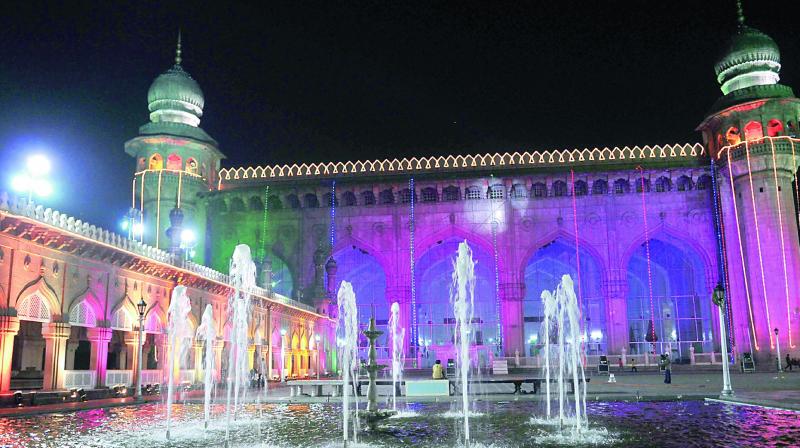Holy soil, granite all part of Macca Masjid
The bricks are just below the roof, above the beehives, while the stone is part of the western wall, about 15 ft from the ground.

Hyderabad: Apart from its name, the Macca Masjid has more connections to the holy city in Saudi Arabia. Soil brought from the holy city was used to make bricks that have been used in the wall on top of the five massive arches on the eastern face of the structure, as also a small stone.
The bricks are just below the roof, above the beehives, while the stone is part of the western wall, about 15 ft from the ground.
“The soil was brought by traders from Macca and used in the eastern wall by the Qutb Shahi kings who began construction of the masjid in 1617 AD,” said Mr M.A. Qaiyum, retired deputy director, archaeology and museums department of AP.
“The bricks were used almost at the roof level for a simple reason. If used at a lower level, they would have been crushed under the weight. The walls are made of granite and are able to withstand the pressure,” said heritage activist and architect Asif Ali Khan.
Maulana Afzal Ali Shah, rector, Madarsa-e-Barkatiya, has a more spiritual reason. “The bricks were used so high up so that they shouldn’t be touched casually and by unclean hands. Sanctity was uppermost in the minds of the builders, hence they used soil from Macca for the bricks,” he said.
On the west of the masjid is a complex that houses relics of the holy Prophet, including a strand of his hair. This strand of hair is put on display on Milad-un-Nabi, along with other relics. Thousands of people visit the masjid on this day every year for a glimpse of the relics.
Sultan Mohammed Qutb Shah began construction of the Macca Masjid, giving the responsibility to Choudhary Rangaiah and Daroga Mir Faizullah. It was left to the Mughal emperor Aurangzeb to complete it in 1693 though he cut the budget of 60,000 Mughal rupees to 30,000 rupees.
In all, about 8,000 labourers toiled for over seven decades to build the main hall, 75-ft-high, 180-ft-deep and 22-ft-wide. There are 15 intricately designed arches that support the roof of the main hall, of which five are constructed on three walls. The masjid is decked with massive Belgian crystal chandeliers and the vast complex can house thousands of devotees.
The mehrab, the niche for the imam who leads the prayers, is carved from a single block of stone. According to Mr Abdul Khadeer Siddiqui, superintendent of the masjid. 1,400 bullocks dragged this block from Gagan Pahad, where all the granite to build the structure came from.
Near the massive ablution pond was a sundial, which still exists but without the nail used to tell the time.
The complex housing the graves of the Asaf Jahi rulers was built much later. As one crosses the ablution pond and steps onto the courtyard, one can see two slabs of black granite, which people sit on. Legend has it that if a traveller sat on these slabs, he or she would return to the city at least once.

